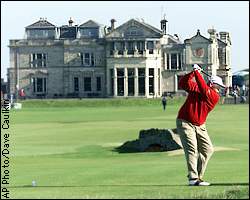Associated Press
Friday, July 14
ST. ANDREWS, Scotland -- About once a month or so, Valerie Melvin takes her bag and 1-handicap down the street and onto the Old Course. The birthplace of golf might be a tough place to get on, but not if you live in St. Andrews, where $155 gives residents annual rights to perhaps the most hallowed course in the world.
 | |
| St. Andrews is unlike any other course golfers will see during their careers. |
ESPN.com: Help | Advertiser Info | Contact Us | Tools | Site Map | Jobs at ESPN.com
Copyright ©2000 ESPN Internet Ventures. Terms of Use and Privacy Policy and Safety Information are applicable to this site.
